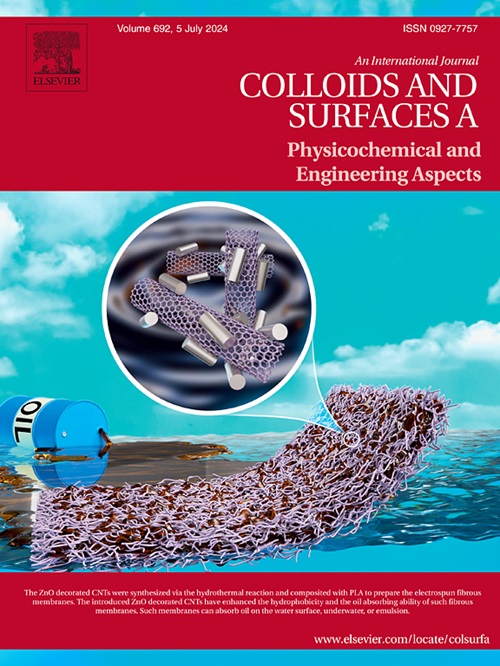Enhanced anodic performance of CTF0 monolayer for Li-ion batteries through F and Si co-doping: A DFT insight
IF 4.9
2区 化学
Q2 CHEMISTRY, PHYSICAL
Colloids and Surfaces A: Physicochemical and Engineering Aspects
Pub Date : 2024-11-12
DOI:10.1016/j.colsurfa.2024.135752
引用次数: 0
Abstract
Covalent triazine frameworks (CTFs) have been identified as promising electrode materials for Li-ion batteries (LIBs) because of their high surface area, adjustable conjugated structures, and good chemical/thermal stability. However, their low electrical conductivity limits electron and ion conduction, leading to poor electrochemical performance. In this work, a novel CTF-based monolayer, namely F and Si co-doped CTF0 (F,Si-CTF0), was designed using density functional theory (DFT) calculations. The results demonstrated that the co-doping of F and Si atoms on the CTF0 surface creates more accessible adsorption sites for Li-ion adsorption. The energy analysis confirmed the stability of the F,Si-CTF0 monolayer, which exhibits a notable adsorption energy of −3.53 eV for Li-ion. The F,Si-CTF0 monolayer can accommodate five Li-ions, providing a theoretical specific capacity of 462 mAh g−1 and a positive redox potential of 2.57 V. adsorption of Li ions on the F,Si-CTF0 monolayer leads to a transition from a semiconducting to a metallic state, resulting in a notable enhancement in electronic conductivity. Moreover, the monolayer undergoes minor lattice variations (1.3 %) throughout the lithiation/delithiation process, demonstrating excellent cycling performance. Finally, Li-ion diffuses rapidly on the monolayer surface with a very small diffusion energy barrier of 0.078 eV. The findings suggest that the F,Si-CTF0 monolayer can be used as a viable anode material in next-generation LIBs. This research shows that F and Si co-doping is an effective and viable strategy for designing two-dimensional CTF-based materials as efficient electrodes for LIBs.
通过掺杂 F 和 Si 增强 CTF0 单层在锂离子电池中的阳极性能:DFT 深入分析
共价三嗪框架(CTFs)因其高比表面积、可调共轭结构和良好的化学/热稳定性,已被确定为锂离子电池(LIBs)的理想电极材料。然而,它们的低导电性限制了电子和离子的传导,导致电化学性能低下。在这项工作中,利用密度泛函理论(DFT)计算设计了一种新型的基于 CTF 的单层,即 F 和 Si 共掺杂 CTF0(F,Si-CTF0)。结果表明,F 原子和 Si 原子在 CTF0 表面的共掺杂为锂离子吸附创造了更多的吸附位点。能量分析证实了 F、Si-CTF0 单层的稳定性,它对锂离子的吸附能量显著为 -3.53 eV。Fi-Si-CTF0 单层可容纳五个锂离子,理论比容量为 462 mAh g-1,正氧化还原电位为 2.57 V。此外,在整个锂化/去锂化过程中,单层的晶格变化很小(1.3%),显示出卓越的循环性能。最后,锂离子在单层表面快速扩散,扩散能垒非常小,仅为 0.078 eV。研究结果表明,F、Si-CTF0 单层可用作下一代 LIB 的阳极材料。这项研究表明,F 和 Si 共掺杂是设计二维 CTF 基材料作为 LIB 高效电极的有效可行策略。
本文章由计算机程序翻译,如有差异,请以英文原文为准。
求助全文
约1分钟内获得全文
求助全文
来源期刊
CiteScore
8.70
自引率
9.60%
发文量
2421
审稿时长
56 days
期刊介绍:
Colloids and Surfaces A: Physicochemical and Engineering Aspects is an international journal devoted to the science underlying applications of colloids and interfacial phenomena.
The journal aims at publishing high quality research papers featuring new materials or new insights into the role of colloid and interface science in (for example) food, energy, minerals processing, pharmaceuticals or the environment.

 求助内容:
求助内容: 应助结果提醒方式:
应助结果提醒方式:


